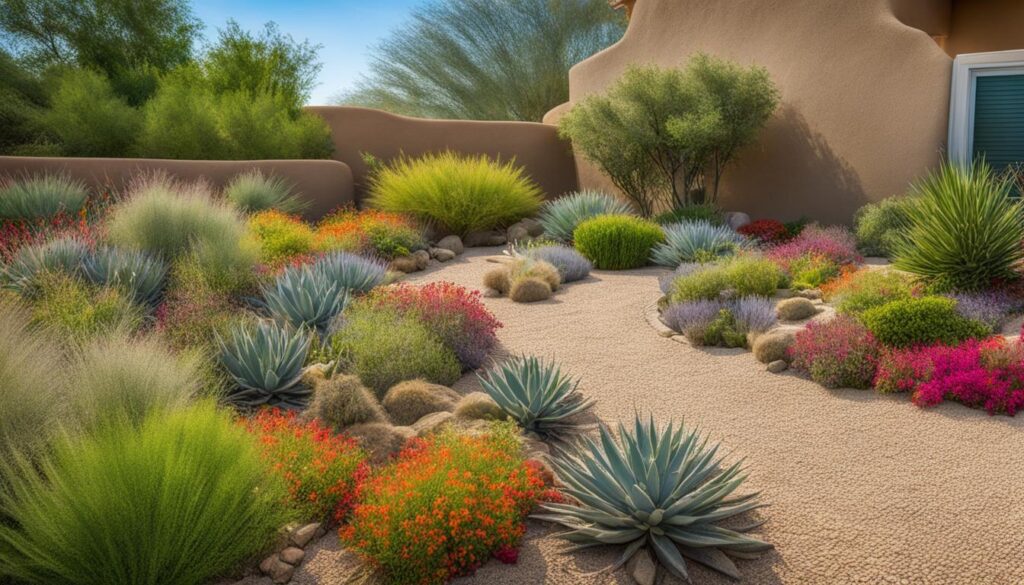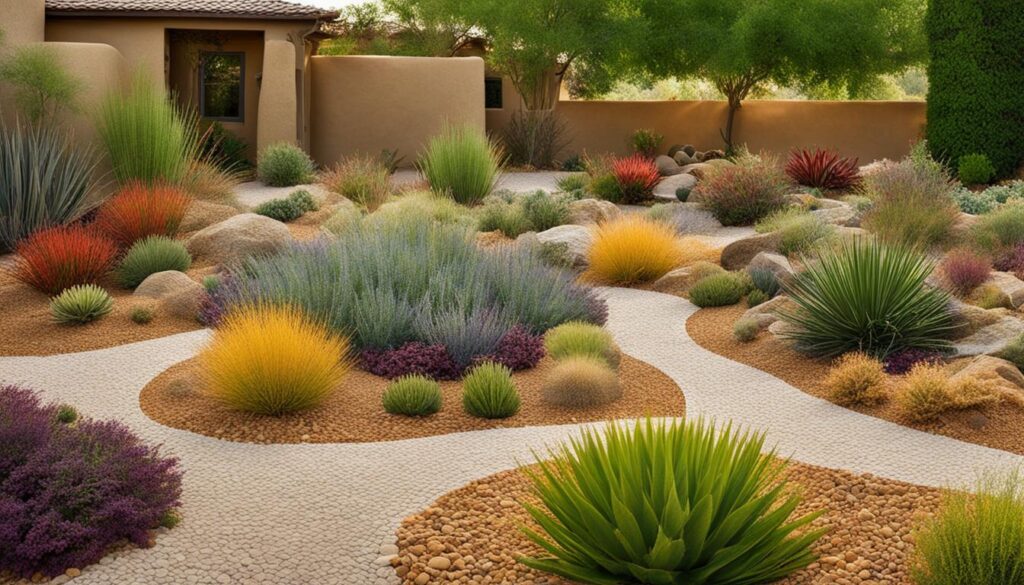Xeriscaping is a landscaping technique that focuses on water conservation and creating a sustainable garden. It involves using drought-tolerant plants, native to the environment, and implementing water-efficient methodologies. Xeriscaping is not limited to desert areas and can be applied in any location. By following best practices and selecting the right plants, beginners can easily create a beautiful and low-maintenance xeriscape garden.
Key Takeaways
- Xeriscaping is an effective method for conserving water and creating a sustainable garden.
- Choosing native and drought-tolerant plants is essential for successful xeriscaping.
- Implementing proper irrigation and soil preparation techniques is crucial for xeriscape gardens.
- Xeriscaping reduces maintenance efforts and costs while promoting water conservation.
- By embracing xeriscaping, beginners can create stunning landscapes that require minimal water and care.
The Benefits of Xeriscaping
Xeriscaping offers several benefits for beginners. One of the main advantages is the ease of maintenance. Native plants, which are commonly used in xeriscape gardens, are adapted to the local climate and require less water and fertilizer. This means that once your xeriscape garden is established, it will require minimal effort to keep it looking beautiful. You won’t need to spend as much time and money on watering, mowing, and pruning, allowing you to enjoy your garden without the stress of high-maintenance tasks.
Another significant benefit of xeriscaping is water conservation. By using drought-tolerant plants and implementing water-efficient techniques, you can greatly reduce your water consumption. Xeriscape gardens can thrive with significantly less water than traditional lawns and gardens, which is not only beneficial for the environment but also for your budget. You’ll see a noticeable decrease in your water bills, making xeriscaping a budget-friendly choice in the long run.
Furthermore, xeriscaping promotes sustainability by reducing the need for artificial irrigation systems and minimizing the use of chemical fertilizers and pesticides. By embracing xeriscaping, you are contributing to the conservation of water resources and creating a more environmentally friendly garden.
Choosing the Right Plants for Xeriscaping
Xeriscaping relies on selecting the right plants that can thrive in dry conditions and require minimal water. When choosing plants for your xeriscape garden, prioritize native species that are adapted to your local climate. These plants have naturally evolved to survive in the region’s specific conditions, making them more drought-tolerant and water-efficient. By opting for native plants, you can create a sustainable and resilient xeriscape garden.
There are several characteristics to look for when selecting plants for xeriscaping. Plants with thick stems and leaves are better equipped to store water during dry periods. Similarly, plants with small leaves, silver or gray-green leaves, or hairy leaves are adapted to conserve water and reduce evaporation. Ornamental grasses are also excellent choices for xeriscaping, as they add texture and height to the garden while requiring less water.
Key Points:
- Choose native plants that are adapted to your local climate for xeriscaping.
- Look for plants with thick stems and leaves, small leaves, silver or gray-green leaves, or hairy leaves.
- Consider adding ornamental grasses to your xeriscape garden for added texture and height.
“Native plants are the backbone of xeriscaping. They are more resistant to pests and diseases and require less water, making them ideal for sustainable gardening.” – Landscaping expert
It’s important to note that xeriscaping doesn’t mean sacrificing beauty in your garden. With the right plant selection and design, you can create a visually appealing landscape that is also water-wise. Take the time to research and choose plants that are well-suited for xeriscaping in your specific region. By incorporating native species and drought-tolerant varieties, you can achieve a vibrant and sustainable garden that thrives with minimal water.
Implementing Xeriscaping Techniques
Implementing xeriscaping techniques is essential to create a successful and sustainable garden. These techniques not only help conserve water but also contribute to the overall aesthetics of your xeriscape landscape. Here are some key aspects to consider:
Selecting Ground Cover Options
Choosing the right ground cover is crucial for xeriscaping. Options like landscaping fabric, rocks, or mulch can enhance the functionality and appeal of your garden. Landscaping fabric provides excellent moisture retention and helps suppress weed growth. Rocks add visual interest, improve drainage, and reduce erosion. Mulch acts as an insulator, moderates soil temperature, and helps retain moisture in the soil.
Optimizing Irrigation
Efficient irrigation is a fundamental part of xeriscaping. Drip or soaker hoses are popular choices as they deliver water directly to the plants’ roots, minimizing wastage. Strategic placement of these hoses ensures that water reaches the intended areas without being evaporated or running off. By utilizing smart irrigation systems and timers, you can further optimize water usage and ensure that your xeriscape garden receives just the right amount of water.
Preparing the Soil
Proper soil preparation is essential for the long-term success of your xeriscape garden. Incorporating organic matter, such as compost or well-decomposed manure, improves soil structure and enhances water penetration and retention. This helps the plants establish strong root systems and absorb water more efficiently. Take the time to till the soil and amend it appropriately before planting, ensuring that you create an optimal environment for your chosen drought-tolerant plants.
“Xeriscaping techniques not only help conserve water but also contribute to the overall aesthetics of your xeriscape landscape.”
Implementing these xeriscaping techniques will set the foundation for a thriving, low-maintenance garden. By selecting suitable ground cover options, optimizing irrigation methods, and preparing the soil properly, you can create a beautiful landscape that requires minimal water and care. Embrace the principles of xeriscaping and enjoy the benefits of a sustainable and environmentally friendly garden.
What are the Best Native Xeriscaping Practices for Beginners?
If you’re new to xeriscaping, consider incorporating native xeriscape ideas for beginners into your landscaping plans. Choosing drought-tolerant plants and utilizing mulch can help conserve water and create a sustainable, low-maintenance landscape. Researching native xeriscape ideas for beginners can provide helpful tips and inspiration to get started.
Conclusion
Xeriscaping is a practical and eco-friendly approach to gardening that offers numerous benefits. By implementing xeriscaping techniques, you can create a sustainable garden that conserves water and reduces maintenance efforts and costs. Not only does xeriscaping promote water conservation, but it also contributes to the overall sustainability of our environment.
With the right plant selection and proper irrigation, beginners can easily create beautiful and resilient xeriscape gardens that require minimal water and care. Embracing xeriscaping not only benefits the environment but also creates a stunning landscape that can be enjoyed for years to come. It’s a win-win situation for both you and the planet.
So, why wait? Start your xeriscape journey today and transform your garden into a drought-tolerant oasis. Experience the joy of sustainable gardening while contributing to the conservation of our precious water resources. Adopt xeriscaping and enjoy a beautiful and eco-friendly landscape that you can be proud of.












